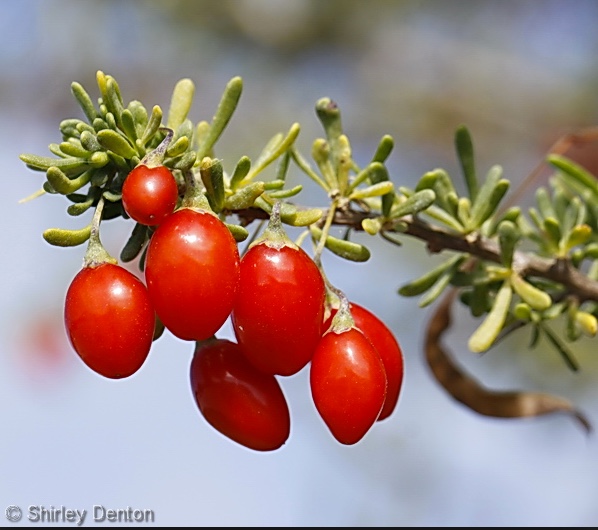
Goji berries are red like their relatives the tomatoes.
The seasons are changing and so is the foraging with a shift into not only fall but winter plants. This locally includes some spring and summer plants found in northern climates. Perhaps the prettiest sighting this past week was Christmasberries. There are several “Christmasberries” but this one in particular is our local Goji Berry. It’s an odd shrub in the Nightshade family and likes brackish water. All the specimens I have found are coastal but usually on the inland water ways that have some tidal influence. They also tend to collect a lot of lichen often Ramlina and or Usnea. I have a video on them and and article here.
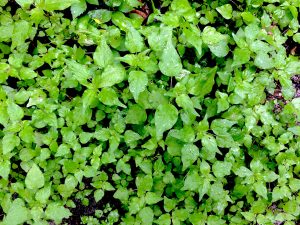
Pellitory has the flavor of cucumbers. Photo by Green Deane
Another winter visitor that has a good start on the season is Pellitory. Usually it begins growing in the northern part of the state first then moves south. I saw some in Vero Beach during a class Saturday and then some in Jacksonville on Sunday. One would think the Pellitory in the northern part of the state would be taller than 200 miles south but not so. Some of the Pellitory in Vero Beach was five inches high, perhaps half it adult size. In Jacksonville the Pellitory was seedlings about an inch high or so. One odd thing about Pellitory is that it has been expanding its season. It used to be only a cooler weather wild edible. Now it is starting sooner in the fall and sometimes lasts into early summer (in shade.) Pellitory is one of two plants locally that smell like cucumber and they are both edible. I have a video on Pellitory and you can read more about it here.
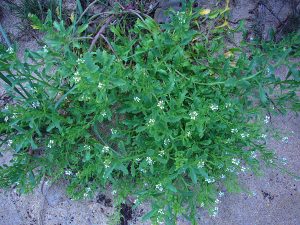
Like all mustards Sea Rocket has four-petal blossoms. There are no toxic mustards. Photo by Green Deane
Up north springtime means mustard time, here fall means mustards. The cooler weather brings them out. You can find some Wild Radishes up now — such as along bike trails east of Orlando to Oviedo — and mustards, too, near Apopka. But not all mustards are the same. I could eat the large wild mustards back home raw. Not so here. I have to cook them or the tummy complains. But two locally that I like raw is our seaside mustards. We have two species of Cakile or Sea Rocket. They shows themselves in our winter and preferably on the beach above the rack line. You can also find them blossoming in coastal dunes. The leaves are a bit fleshy but as they are in a tough environment that helps them preserve water. While Sea Rocket can be found along most coasts of the United States, Maine to Washington State, Florida has its own variety, C. lancelolate. There is a video on them here and you can read more about them here.
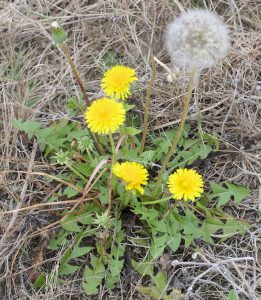
Nearly all of the Dandelion is edible. Photo by Green Deane
Where have all the Dandelions gone? If you’re in a northern clime they are waiting for spring and summer. Locally Dandelions do not like our hot summers so they go through their growth cycle in the winter. Life is precarious for a Dandelion hereabouts. While you can find an occasional one any time of year they become more common in the cooler months. You start to find small ones around November, basal rosettes first. Between now and February they’ll send up blossoms. It’s a short-lived success in February because the nights can also be close to freezing. The other problem is they never get as large here as they do in northern climates, rarely more than a foot high. To find Dandelions you first have to identify acidic soil. Florida is a limestone door stop under the North American Plate. So you have to look for Dandelions where the soil is on the acidic side, such as under pines, oaks or not-so-wet cypress. That is also where to look for blueberries. To see my video on Dandelions go here, to read more about Dandelions, click here.
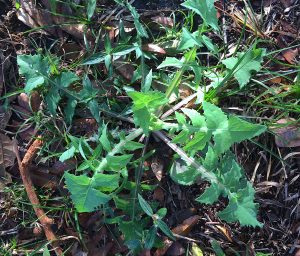
Sow Thistles make a nice winter pot herb. Photo by Green Deane
Another not unexpected surprise this weekend was the sighting of Sow Thistles in Jacksonville. A Dandelion relative it, too, prefers the cooler months locally. Not a true thistle it is one of the more milder seasonal greens with only perhaps Amaranth being more mild. Although Sow Thistles are commonly called “thistles” they are not in the genus and do now draw blood like true thistles. True thistles are well-armed with needle-sharp spines. While the Sow Thistle can look intimidating it’s mostly just show in that most spines are soft. There are two species locally, the Common Sow Thistle and the Spiny Sow Thistle. The latter is a bit rougher than the former but no where near as abusive as true thistles. Both are slightly bitter raw. A few minutes of boiling takes away the bitterness completely (unlike wild lettuce which always stays slightly bitter.) I have a video on the sow thistles and to read more about them go here.
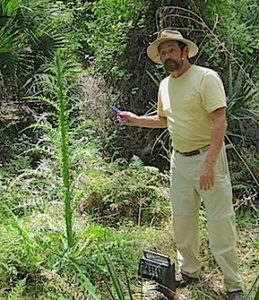
Foraging classes are held rain or shine. Photo by Nermina Krenata
Foraging Classes: The two immediate classes this coming weekend include John Chestnut Park north of Tampa and Boulware Springs in Gainesville.
Saturday, November 18th, John Chestnut County Park, 2200 East Lake Road, Palm Harbor, FL 34685. 9 a.m. Meet at the trail head of the Peggy Park Nature Walk, pavilion 1 parking lot.
Sunday, November 19th, Boulware Springs Park, 3420 SE 15th St., Gainesville, FL 32641. 9 a.m. Meet at the picnic tables next to the pump house.
Sunday, November 26th, Blanchard Park, 10501 Jay Blanchard Trail, Orlando, FL 32817. 9 a.m. Meet by the tennis courts near the WMCA building.
Saturday, December 2nd, Red Bug Slough Preserve, 5200 Beneva Road, Sarasota, FL, 34233. 9 a.m.
Sunday, December 3rd, Dreher Park, 1200 Southern Blvd., West Palm Beach, 33405, 9 a.m. We meet just north of the science center.
Sunday, December 10th, Bayshore Live Oak Park, Bayshore Drive. Port Charlotte. Meet at the parking lot at the intersection of Bayshore Road and Ganyard Street. 9 a.m.
To learn more about the classes go here.
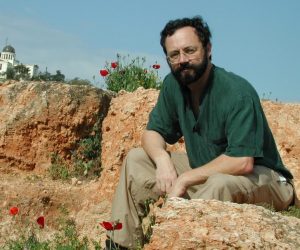
The Nine DVD set includes 135 videos.
All of Green Deane’s videos available for free on You Tube. They do have ads on them so every time you watch a Green Deane video I get a quarter of one cent. Four views, one cent. Not exactly a large money-maker but it helps pays for this newsletter. If you want to see the videos without ads and some in slightly better quality you can order the DVD set. It is nine DVDs with 15 videos on each for a total of 135 videos. Many people want their own copy of the videos or they have a slow service and its easier to order then to watch them on-line. The DVDs make a good gift for that forager you know especially on long, cold winter months. Individual DVDs can also be ordered or you can pick and choose. You can order them by clicking on the button on the top right hand side of this page (if your window is open wide enough.) Or you can go here.
 Want to identify a plant? Looking for a foraging reference? Do you have a UFO, an Unidentified Flowering Object you want identified? On the Green Deane Forum we chat about foraging all year. And it’s not just about warm-weather plants or just North American flora. Many nations around the world share common weeds so there’s a lot to talk about. There’s also more than weeds. The reference section has information for foraging around the world. There are also articles on food preservation, and forgotten skills from making bows to fermenting food. One special section is “From the Frightening Mail Bag” where we learn from people who eat first then ask questions later. You can join the forum by clicking on “forum” in the menu.
Want to identify a plant? Looking for a foraging reference? Do you have a UFO, an Unidentified Flowering Object you want identified? On the Green Deane Forum we chat about foraging all year. And it’s not just about warm-weather plants or just North American flora. Many nations around the world share common weeds so there’s a lot to talk about. There’s also more than weeds. The reference section has information for foraging around the world. There are also articles on food preservation, and forgotten skills from making bows to fermenting food. One special section is “From the Frightening Mail Bag” where we learn from people who eat first then ask questions later. You can join the forum by clicking on “forum” in the menu.
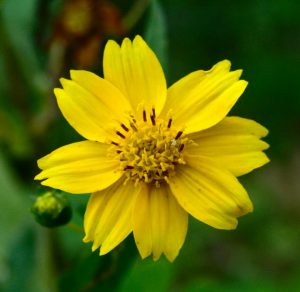
Guizotia abyssinica, the Niger Seed.
And while mentioning thistles when you buy thistle seed in the United States to feed birds (or yourself) know they are not thistle seeds, despite the label. They are seeds of the Guizotia abyssinica, the Niger Seed which is really from the highlands of Ethiopia. Often sold as finch food the seeds are fried, used as a condiment, dried to make a chutney, or mixed with honey and made into sweet cakes. The oil is a substitute for Ghee. Imports of the seed became dicey after the U.S. government in 1982 said untreated seeds were adulterated with seeds from at least nine noxious weeds five of which are edible: African couchgrass, red rice, kodo millet, onion weed, and mesquites. A 2001 law required that imported Niger seed be heated to 248 °F (120 °C) for 15 minutes to stop any germination. A variety of G. abyssinica, EarlyBird Niger, was developed in 2002 and adapted to the United States. It is now in commercial agricultural production in the U.S.
Did You Know? There’s a reason why your bamboo shoots are cooked, or need to be cooked. They contain a form of proto cyanide. The cyanogenic glycoside in bamboo is taxiphyllin. Taxiphyllin is unusual among the sixty or so known similar compounds in that it degrades readily in boiling water. That’s why you buy bamboo shoots cooked or you cook them. Cooking gets rid of the problem, keeps you alive.
This is issue 278. The main portion of the website is now functional though small bugs persist. For example the comment section doesn’t work… We are working on them. Thanks for you patience.
If you would like to donate to Eat The Weeds please click here.

